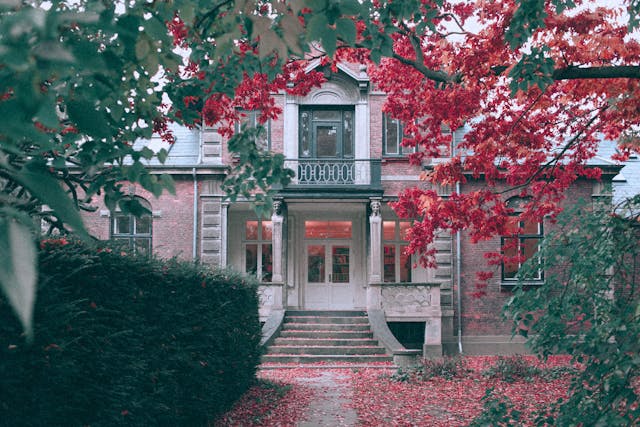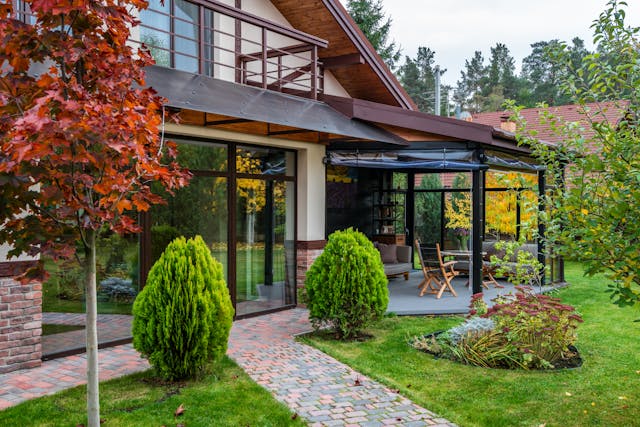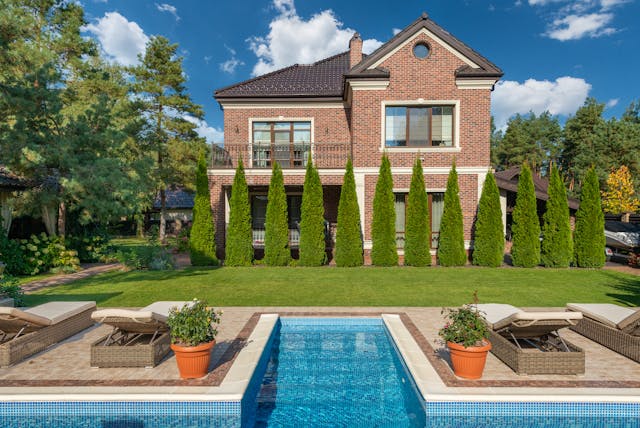To create a plan you’ll enjoy for years to come, use these garden design ideas as a guide. We’ve put together some amazing garden ideas to help you revamp your backyard, and it will also increase the value of your house. Whether you’re searching for garden landscaping ideas to redo your outdoor area, no matter how large or tiny, attract more animals, or be more sustainable.

In order to help you create an outside place you can really appreciate, we also provide advise and style suggestions on garden furniture, pavement, lighting, plants, borders, decking, and more.
However, it’s crucial to examine your garden as a whole before moving forward with any redesigns or modifications, advises Andrew Kyte of The Chelsea Gardener. “Find out as much as you can about the garden’s position, direction, and outlook.” This will not only impact planting, but it may also determine how you utilize the area.
Regardless of the size of the garden—small, long and narrow, cottage, or courtyard—you should pay attention to the locations and times of day when the garden receives sunlight. Consider your garden’s accessibility as well as your intended uses, such as gardening and producing vegetables, lounging on the sundeck, hosting outdoor meals, or just relaxing with a cup of tea on a bright morning.
Once you have the answers to these, you’ll know precisely how you want your garden to function for you. We hope that these garden design ideas will help you become creative.
Makeover your grass.
Your grass is most likely the largest shape in your landscape when you look out your window. If the form is sound and robust, it will put the whole garden in the appropriate direction. Additionally, keep in mind that you may attempt an oval, circular, square, or oblong form instead of a rectangle. To do the task, you’ll need the appropriate tools. Price comparison website PriceRunner said that last year witnessed an increase in searches for stylish robotic lawn mowers and ride-on mowers. Among them, the Flymo Easi Glide 300 Electric Mower was a top seller.
Stuart Thomas, a horticulture expert at the online garden center Primrose, offers the following advice for continuous lawn care and maintenance: “If your lawn is looking lackluster, consider the three tenets of sunshine, showers, and soil aeration.” Trim down branches to avoid overshadowing. If the UK’s regular rain isn’t enough, water once a week early in the morning. Make plenty of holes in your grass with a fork to allow for aeration. If you follow through on all of them, your grass will become lush in no time. Also, avoid cutting it too short!”
But with the popularity of natural wildlife gardens, you may want to let your grass grow longer and learn about what wildflowers bloom naturally rather than using a lawnmower. According to landscape designer Ann-Marie Powell, “people want gardens that look like they are “of nature” rather than the more obviously designed spaces,” and this plays very much into the rewilding movement. Continue reading: Is it better to mow or not mow the vast lawn?

Make a gardening plan.
The most beautiful garden designs begin with skeletal plants that are interspersed with fragrant blooming plants. Thus, utilize evergreen bushes as a punctuation along the path and at the conclusion of each border. For larger settings, use giant evergreens like mahonia or little shrubs like box balls.
After you have this frame, use attractive blooming plants to fill in the spaces. For a coordinated and harmonious look, try to limit your selection to no more than five or six distinct varieties and arrange them in repeating patterns. A border should be at least one meter deep, allowing you to arrange smaller plants in front and bigger ones behind.
Recall that lines of planted-up troughs or narrow, low-planted beds may delineate dining or sitting spaces. Use evergreen, fragrant plants like Mexican orange blossom or lavender. The most versatility, however, is provided by containers, which you may arrange anyway you see fit. According to Tony Woods, general director of garden design firm Garden Club London, “creeping rosemary is a great plant for edging in containers as it trails rather than growing upright, is evergreen, and covered in blue flowers in spring.”
Climbers in the rear of the border may help you achieve planting height even if there isn’t enough space for meters-deep beds. When it comes to climbing plants, choose for an evergreen like clematis for a lovely and vibrant show.
Tony suggests star jasmine for places with seats: “It’s perfect for placing behind a seating area where you don’t want plants hanging over and can enjoy the scent because it’s very well-behaved, produces masses of white, waxy, scented flowers throughout the summer, and reacts well to being cut back.”
Aim for some ‘out of season’ performances when selecting blooming plants so that you have color throughout the year. You can also start the garden off well by adding spring and early summer bulbs.
The Samphire Garden by Sue Townsend shows how to design a garden that is full of texture and visual appeal while still being good for the environment, if you’re seeking for methods to make your garden more sustainable.
The coastal garden in Suffolk, which is paved with locally recovered York Stone, has a diverse variety of drought-tolerant plants, such as native beach plants, Mediterranean shrubs, and grasses, all encircled by varying-sized stone mulch. Among the plants are verbena bonariensis, eryngiums, euphorbias, thymus, achillea, ballota, miscanthus nepalensis, and pennisetum. Make sure the surfaces you utilize are porous so that water may naturally seep into the ground.
exquisite pavers
Your garden’s overall design may be strongly influenced by the color, style, and installation of your pavers. For example, a French country appearance may be achieved with grey or white stone placed in an irregular pattern; a sleek and contemporary plan can be perfectly complemented by black or silver pavement put in a regular arrangement; and an English country feel can be achieved with golden stone arranged in an irregular pattern.
Do you need some motivation? Butter Wakefield’s Ribbon Wheel garden has an intricate pavement pattern consisting of ten interlocking circles, each with a unique shape and dimension, joined together by a ‘ribbon’ of York cobblestones. The circles, which are made of York and limestone stone mixed together, are put in a pattern of cobbles and setts to provide an amazing appearance.
Paying close attention to detail is essential if you want to design the garden of your dreams. Plants and pavement should be coordinated to create a lovely design. As an illustration:
Purple and white blossoms look fantastic with grey or white stone.
Paving in black and silver complements vibrant colors like red, orange, and yellow well.
Pastel pink, lavender, and pale yellow flowers complement golden pavers well.
“Think about something new and exciting like large-format porcelain paving instead of jet washing the old worn paving,” advises Michael John McGarr, director and landscape designer at Warnes McGarr & Co. Since porcelain does not absorb water, it needs less maintenance than conventional pavement materials. This translates to fewer pressure washing sessions and a significant reduction in labor-intensive tasks over time.
In any case, designing a path that leads from your house to the garden is a smart idea. “You can make it difficult to tell the difference between the inside and outside of the property by making sure your paving is level with your indoor flooring,” said Michael.
Trees
An established tree may serve as a foundation for a plan. In addition to serving as an anchor for hanging decorations, hammocks, pendant lights, and shade sails, they also hide the sun’s glare.
If you live next to a busy road, trees may also assist filter noise pollution and an ugly view. Additionally, they greatly aid the environment by turning carbon dioxide in the air into oxygen, giving insects and birds refuge and pollen.
Multi-stem trees are becoming more and more popular. Planting them may provide an architectural focal point because of their graceful canopies, which lend themselves to layered underplanting or, if planted alone, can make a dramatic structural statement. Multi-stem trees and soft planting, as seen in this contemporary Suffolk garden by Caitlin McLauglin below, create a deconstructed forest experience in a front courtyard garden.
“Trees are an excellent source of carbon capture, food, and habitat for wildlife.” According to Sarah Squire, Chair of Squire’s Garden Centers, “They also give a garden structure and architecture.” “There are trees for every size and shape of garden; some of my favorites are hornbeam, whitebeam, and birch, but there are also gorgeous flowering cherries in back gardens and tiny potted acers for balconies.”

Different levels
Are there multiple levels in your garden? If the thought of adding stone stairs bothers you, you may still have a seamless appearance with your current lawn by making it possible for one area to flow into another. As seen in the image below, landscape designer Helen Elks-Smith connected the lower patio to the little sun terrace above by using grass treads and blending them into the existing lawn.
Searching for inspiration for your deck? Installing decking is a great and affordable way to level off an uneven or sloping landscape. Because it is used for eating chairs, decking may also feature stairs and split levels. A decked garden area usually has to resist significant foot traffic.
Millboard’s composite decking boards are made of a revolutionary mixture of polyurethane and minerals, making them environmentally sustainable, non-slip, and low care. They provide the beauty and flexibility of genuine wood, but without the upkeep. Because of its nonporous upper layer, this wood-free decking almost cleans itself; rain does the heavy lifting.
The furnishings
Choose foldable furniture or bench seating that can be stowed beneath a dining table when not in use for smaller courtyards and patios. While bigger rooms may accommodate full-on sitting sets with matching chairs, couches and tables, sun loungers and day beds, or on-trend hanging egg chairs or swing seats, L-shaped sofas can be surprisingly small.
Invest in a high-quality, long-lasting outdoor furniture set. Take into account the available area and make sure there is enough room for everyone to sit comfortably and draw out their chair without running into anything. Additionally, keep in mind that when everyone is seated, you will need space to stroll around the table. It requires a lot more room than you may imagine!
“A dining table works best in the area of the garden that has early afternoon full or partial sun,” says Claire Belderbos, head of garden landscaping experts Belderbos Landscapes. Create a little sitting area so you can take in the evening light.
For instance, purchase furniture coverings to preserve and prolong the life of your three-piece set if you are unable to take it inside during the winter. Additionally, remember to add outdoor cushions to your garden furniture purchase for added comfort.
Not to mention other essential garden features like pizza ovens, fire pits and chimineas, patio heaters, grills, and ovens; space planning is essential for these as well as for where they will be kept safe and stored during the winter.
Be mindful of your limits.
Boundary walls, fences, and hedges might be the largest feature in a tiny garden, thus their appearance matters a lot. While they don’t have to be identical, make an effort to create visual connections between them. For example, you may plant climbers in complementary colors up the same sort of fence. If you can’t alter the fences, consider giving them a coat of whitewash or covering them with trellis or battens. Before doing any work, confirm with your neighbors whose fence it is and get their permission.
The materials you choose are also crucial. Timber stakes, for instance, don’t only have to be used for securing a garden from the neighbors. When strategically placed in a garden, they may be utilized to accentuate borders or pathways, frame sitting areas or plants, and create visual appeal.
The NHS 70 Garden for Addenbrooke’s Hospital, designed by garden landscape business Bowles & Wyer, is an example of a highly creative use. Reclaimed wood posts were positioned at various heights and angles to frame the vista along the meandering route in its center, revealing new facets to guests as they go through.
Zoning and screening
Additionally, consider screening off certain sections of your garden to create distinct “rooms.” Use plants to introduce hard landscaping, such as fences or pergolas. Tall bamboo or sturdy rose plants are a great choice, according to Garden Trading CEO Jon Holloway. As an alternative, arrange a row of potted trees.
Although this is an excellent concept for all shapes and sizes of gardens, zone some portions of your garden if you are short on space. “There’s no denying that the garden expands the kitchen and living area,” remarks Vicky Angell, John Lewis & Partners’ buyer for outdoor living. “We’re looking to the outdoors for space to entertain and relax, in part because our homes are, on average, smaller than ever.”
Adorn the fifth room with accessories.
Consider how you might use cozy garden décor and plush furniture to transform your outside area into a tranquil haven. Basically, you want to create the illusion that you are in an outdoor living room, so keep that in mind while you are shopping for accessories and décor.
For an appealing and cozy look, you might, for instance, invest in an outdoor rug (Cuckooland has a nice range of Fab Hab rugs made from recycled plastic) and pair it with lanterns, outdoor cushions, and chunky knit blankets. Invest in a waterproof speaker, use a garden mirror to reflect light around your selected area, use citronella candles to ward off insects, use a patio heater to stay warm at night, and, last but not least, scatter tiny potted plants over the area in a similar manner to how you would with houseplants.
Include your decorations
Nestle garden decorations in with the planting; this is the most crucial guideline to follow. Select carefully since an ornament or water feature that is placed in the middle of an empty area is unlikely to look nice, even if it is fantastic for wildlife. When it comes time to sell, keep in mind that anything too large may overtake the space and seem lost if it is too little. The latter has also been known to lower the value of your house.
If you want the sound of trickling water trickling through your garden but aren’t interested in installing a fountain, consider a simple stone trough with a water spout, such to the one that’s part of Butter Wakefield’s Ribbon Wheel landscape (below). The ancient trough’s design has wall panels suspended above it, as well as antiquated mirrors that reflect the garden beyond and a dark gray paint job that contrasts with the green foliage around it.
Construct a garden room
Planning approval is typically not needed for a garden room, which is a terrific way to make the most of and expand your space—whether you want it for a home office or a yoga studio. Whether it’s a sizable shed or summerhouse, it may be the ideal location for hosting visitors in the summer and serve as extra lodging as well. Consider methods to transform your backyard into something more than a space for dining, entertaining, and sunbathing.
